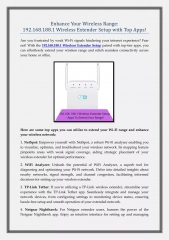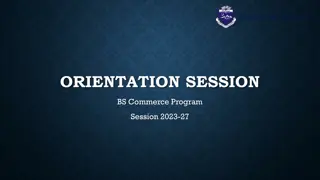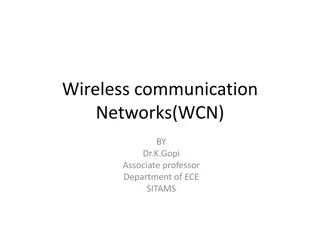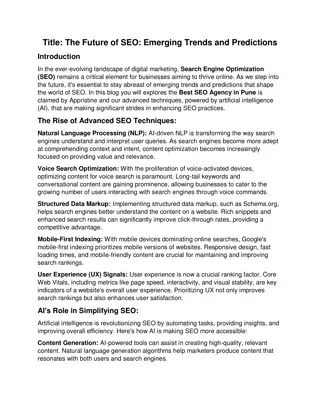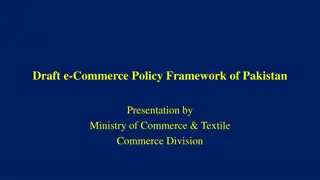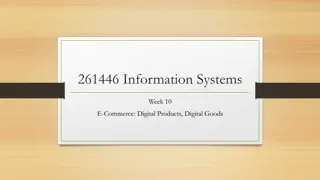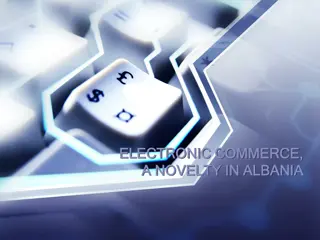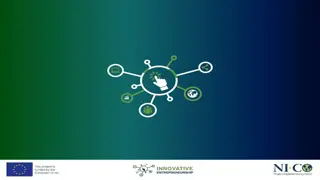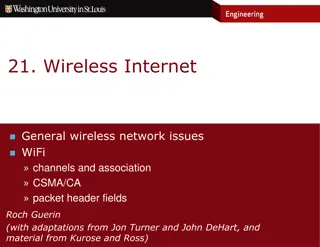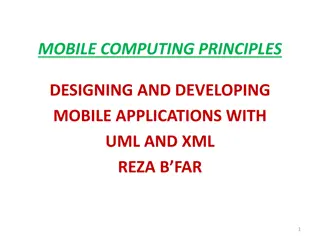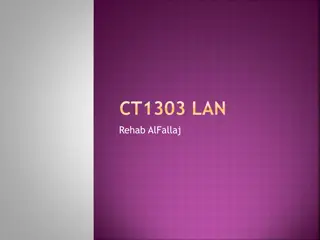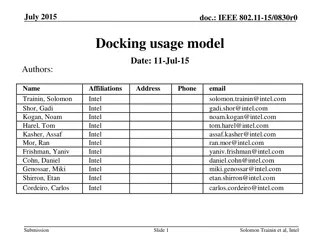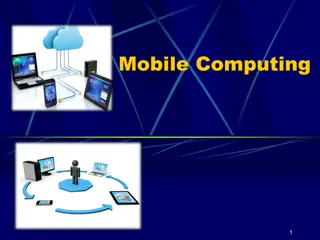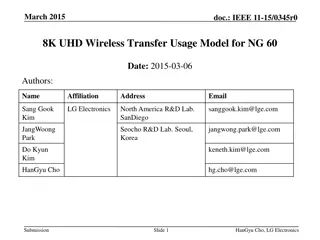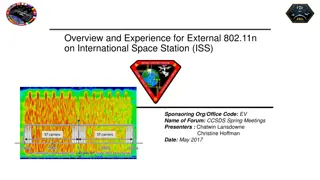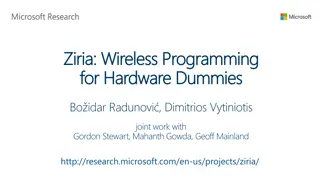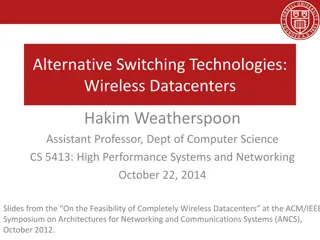Exploring Wireless Technologies and Mobile Commerce
Delve into the realm of wireless technologies, mobile computing, and mobile commerce with a focus on the advantages and disadvantages of wireless transmission media, business applications of short-range to long-range networks, m-commerce benefits for businesses, technologies in pervasive computing, threats to wireless networks, and more. Discover the potential of modern smartphones and how they revolutionize healthcare in contexts like Uganda. Uncover the complexities of the battle for the mobile wallet and learn valuable insights from real-world cases in the dynamic landscape of wireless and mobile technologies.
Download Presentation

Please find below an Image/Link to download the presentation.
The content on the website is provided AS IS for your information and personal use only. It may not be sold, licensed, or shared on other websites without obtaining consent from the author.If you encounter any issues during the download, it is possible that the publisher has removed the file from their server.
You are allowed to download the files provided on this website for personal or commercial use, subject to the condition that they are used lawfully. All files are the property of their respective owners.
The content on the website is provided AS IS for your information and personal use only. It may not be sold, licensed, or shared on other websites without obtaining consent from the author.
E N D
Presentation Transcript
8 Wireless, Mobile Computing, and Mobile Commerce
LEARNING OBJECTIVES 1. Identify advantages and disadvantages of each of the four main types of wireless transmission media. 2. Explain how businesses can use technology employed by short-range, medium-range, and long-range networks, respectively. 3. Provide a specific example of how each of the five major m-commerce applications can benefit a business. 4. Describe technologies that underlie pervasive computing, providing examples of how businesses can utilize each one. 5. Explain how the four major threats to wireless networks can damage a business.
CHAPTER OUTLINE 1.Wireless Technologies 2.Wireless Computer Networks and Internet Access 3.Mobile Computing and Mobile Commerce 4.Pervasive Computing 5.Wireless Security
[ The Battle for the Mobile Wallet ] The Problem A Variety of Solutions Mobile Phone Carriers Credit Card Issuers Technology Companies The Results What We Learned from This Case
ITs [about business] 8.1 Big Wheel Mobile Truck & Square
8.1 Wireless Technologies Wireless Devices Smartphones Wireless Transmission Media Microwave Satellite Radio
Wireless Devices Three Major Advantages for Users Small enough to easily carry or wear. Sufficient computing power to perform productive tasks. Communicate wirelessly with the Internet & other devices. One Major Disadvantage for Business Workers can capture and transmit sensitive proprietary information
Modern Smartphone Capabilities Cellular telephony Bluetooth Wi-Fi Digital camera for images & video Global Positioning System (GPS) Organizer Scheduler Address book Calculator E-mail Short Message Service (SMS, sending and receiving short text messages up to 160 characters in length) Instant Messaging Text messaging MP3 music player Video player Internet access with full- function browser QWERTY keyboard
[about business] 8.2 Cell Phones Revolutionize Healthcare in Uganda
8.2 Wireless Transmission Media (WTM) Wireless Media (aka, broadcast media) transmit signals without wires Major Types of Wireless Media Channels: Microwave Satellite Radio Infrared
WTM: Microwave Advantages Disadvantages High bandwidth Relatively Inexpensive Requires an unobstructed line of sight Susceptible to environmental interference
WTM: Satellite Advantages Disadvantages High bandwidth Large coverage area Expensive Requires unobstructed line of sight Signals experience propagation delay Requires the use of encryption for security
Three Basic Types of Telecommunications Satellites Geostationary Earth Orbit (GEO) Middle Earth Orbit (MEO) Low Earth Orbit (LEO)
Geostationary Earth Orbit (GEO) Orbit: 22,300 miles 8 TV Signal Number of Satellites: Use: Characteristics: Satellites stationary relative to point on Earth Few satellites needed for global coverage Transmission delay (approximately .25 second) Most expensive to build and launch Longest orbital life (many years) A A A A A A a
Internet over Satellite (IoS) Disadvantages Advantages Provides Internet services to remote areas of Earth Propagation delay Disrupted by environmental conditions
Middle Earth Orbit (MEO) Orbit: 6,434 miles 10 - 12 Global Positioning Systems (GPS) Number of Satellites: Use: Characteristics: Satellites move relative to point on Earth Moderate number needed for global coverage Requires medium-powered transmitters Negligible transmission delay Less expensive to build and launch Moderate orbital life (6 12 years) A A A A A A a
Global Positioning Systems (GPS) A wireless system that utilizes satellites to enable users to determine their position anywhere on Earth. Supported by 24 MEO Satellites Uses of GPS Navigating, Mapping, Surveying, 911 location Three additional GPS Systems GLONASS, Russia 2005 Galileo, European Union 2015 Beidou, China 2020
Low Earth Orbit (LEO) Orbit: 400 - 700 miles Many Telephone, Internet Number of Satellites: Use: Characteristics: Satellites move rapidly relative to point on Earth Large number needed for global coverage Requires only low-power transmitters Negligible transmission delay Least expensive to build and launch Shortest orbital life (as low as 5 years) A A A A A A a
WTM: Radio Advantages Disadvantages High bandwidth Signals pass through walls Inexpensive and easy to install Creates electrical interference problems Susceptible to snooping unless encrypted
WTM: Infrared Advantages Disadvantages Low to medium bandwidth Used only for short distances Requires an unobstructed line of sight
8.2 Wireless Computer Networks & Internet Access Short-Range Wireless Networks Medium-Range Wireless Networks Wide-Area Wireless Networks
Short-Range Wireless Networks Bluetooth Ultra-Wideband Near-Field Communications
[about business] 8.3 Near-Field Communications Helps Travelers in Japan
Medium-Range Wireless Networks Wireless Fidelity (Wi-Fi) Wireless Local Area Networks (WLAN) Wi-Fi Direct MiFi Super Wi-Fi Wireless Mesh Networks
[about business] 8.4 Airlines Provide WiFi to Passengers
Wide-Area Wireless Networks Cellular Radio (Cellular telephones) 1G 2G 3G CDMA EV-DO GSM 4G Wireless Broadband (or WiMax)
8.3 Mobile Computing and Mobile Commerce Mobile Computing Refers to a real-time connection between a mobile device and other computing environments, such as the Internet or an Intranet. Mobile Commerce Electronic commerce (EC) transactions conducted in a wireless environment, especially via the Internet.
Mobile Computing Two Major Characteristics Mobility Broad Reach Mobility & Broad Reach Create 5 value-added attributes 1. Ubiquity 2. Convenience 3. Instant connectivity 4. Personalization 5. Localization of Products and Services
Mobile Commerce Also known as M-commerce Drivers of M-commerce Widespread availability of mobile devices Declining prices Bandwidth improvement
Mobile Commerce (continued) Mobile Commerce Applications Include: Location-Based Applications and Services Financial Services Intrabusiness Applications Accessing Information Telemetry Applications
[about business] 8.5 Mobile Ads Still Aren t Very Good
8.4 Pervasive Computing Invisible everywhere computing that is embedded in the objects around us. Radio-Frequency Identification (RFID) Versus bar codes Versus QR codes Wireless Sensor Networks
[about business] 8.6 BP Uses Wireless Technologies
[about business] 8.7 Brazil Uses Smart Meters
8.5 Wireless Security Four Major Threats Rogue access points War driving Eavesdropping Radio-frequency jamming
[ Closing Case Retailer Gains Many Benefits with RFID Item-Level Tagging] The Problem The IT Solution The Results


